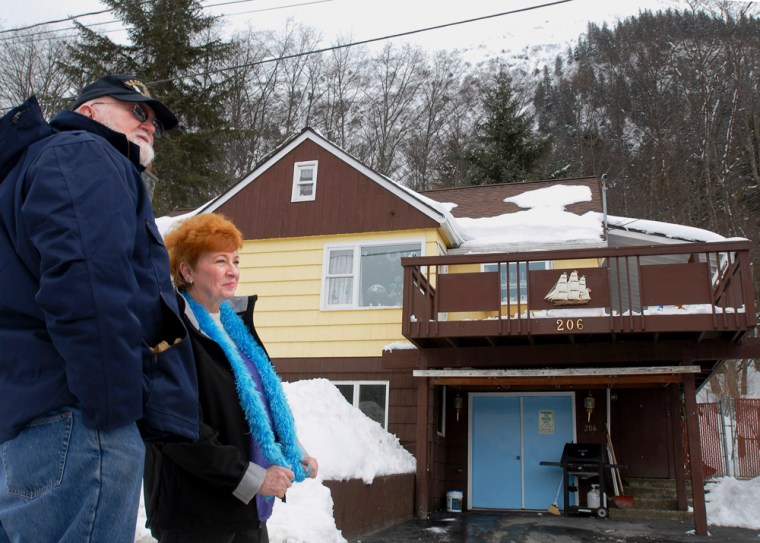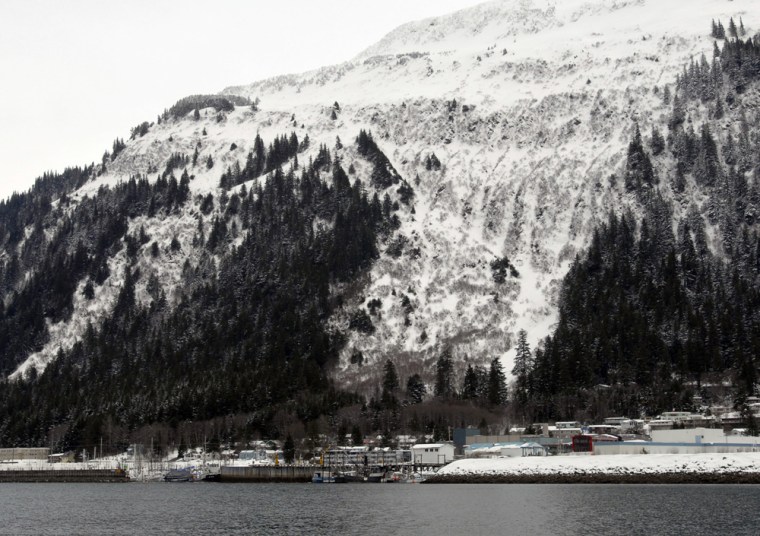Butch Holst and his wife were thrilled in 1978 when they sealed a deal on a downtown home at the foot of Mount Juneau. Thrilled, that is, until someone showed them a photo of their house in a National Geographic article that said Juneau has the highest risk of an avalanche disaster of any city in America.
"That was our first indication that there was a serious problem," said Janice Holst, a dance teacher and grandmother of 12.
Almost 30 years after moving in, she still gets jumpy when winter sets in. And despite her husband's assurances, a barrage of alerts this year from the city's new online avalanche-forecasting system has been particularly unnerving.
Earlier this week, with record snowfall piled up on the mountain above and a storm in the forecast, the Holsts threw together important papers and clothes and spent the night at their son's house in a safer part of town. Nothing happened.
"Butch is losing his energy to say, 'It's not going to happen, it's not going to happen,' and I'm like a crazy, clucking hen running around saying, 'Everybody get ready. The sky's going to fall,'" Janice Holst said with a nervous laugh.
More than 60 homes, a busy boat harbor and sections of a main thoroughfare in Alaska's capital city are considered at risk from at least a dozen chutes that sweep off the steep and burly shoulders of Mount Juneau. Small slides let loose all the time, but the only reported death was in 1971, when a mountain climber hiked up into an avalanche path and was buried in a slide that he triggered.
The costliest slide on record, in March 1962, was an airborne blast of powdery snow that blew off roofs, knocked houses off their foundations and hurled trees through walls and windows. No one was seriously hurt, though 17 homes had significant damage.
Specialists say it is only a matter of time before another big one hits Juneau, and it could make the 1962 slide look puny.
But measures such as snow barriers and property buyouts or condemnation have proved beyond the city's financial and political reach. Juneau officials say all they can do is urge residents to stay informed and be prepared to leave their homes if the danger is high.
To that end, the city this year funded an urban avalanche forecasting office — the only one in North America — that will operate through April.
Southeast Alaska Avalanche Center Director Bill Glude and a staff of three combine observations at ground level and higher elevations with weather reports and historical information to build the daily forecasts. So far, there have been several slides this season, but none reached homes.

On a recent evening, Glude pegged the avalanche danger as extreme — "off the charts," in fact — with heavy snow, strong winds and rain expected to batter the higher elevations.
A young woman who had seen the alert on the center's Web site telephoned to say she was worried about a friend living in one of the threatened neighborhoods.
"If I had a friend in the avalanche zone, I would be advising them not to stay home tonight," Glude explained.
But he could not tell her much more.
"It's like a salmon run," he told the caller. "Basically what we can say is the salmon are going to be running. The avalanches are going to be running tonight. But whether or not a particular path runs is like saying whether or not you will catch a particular fish on your rod."
The Juneau area has gotten more than 16 feet since November. Spring is a particularly dangerous time of year for avalanches because melting and rainfall can set snow in motion.
Riley Woodford, whose house under a previous owner was slightly damaged in the 1962 slide, checks the Web site daily and sometimes sleeps in the basement or stays with friends.
"We are so lucky that of all the years they decided to fund avalanche forecasting, it's the one year we've had this kind of snowfall. It's great timing," Woodford said.
But because avalanches are notoriously difficult to forecast, and years have gone by without a serious incident, other residents have become complacent.
Greg Pilcher, who recently bought his father's house in the avalanche zone, said the Web alerts are a great idea, but he doesn't check them.
"It's almost like the terror rating, like being on `orange elevated.' It's this constant paranoia you are supposed to have," Pilcher said.
Avalanche forecasting is common in Europe. In Iceland, when the danger gets too high, citizens are required to evacuate. The city of Juneau doesn't have the legal authority to do that, and if it tried, Glude predicts the backlash would shut down his program.
"When you disrupt everybody and force them to evacuate, people get resentful pretty quickly, especially Alaskans, because we don't like government telling us what to do," Glude said.
The only long-term solution, he said, is a voluntary buyout of homes in danger. Experts say that would cost a fraction of the price of snow barriers, which are imperfect anyway, since they can be breached and can actually destabilize the slopes.
Butch Holst said he is not convinced the risk is high enough to sell out.
"They beat their gums a lot. But I've been here since 1978 and I've never tried to sell out and move," he said.
